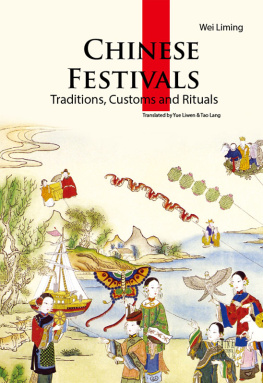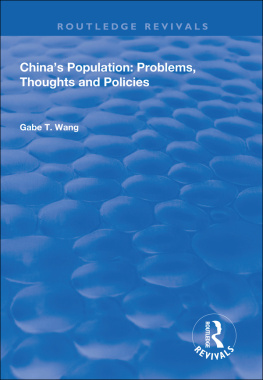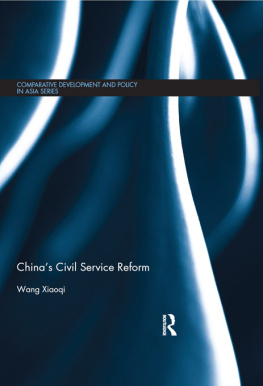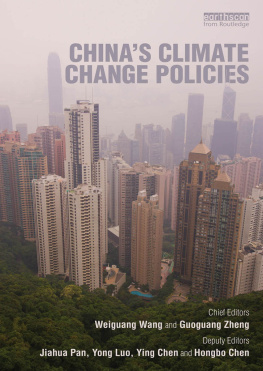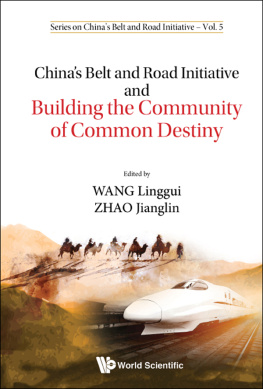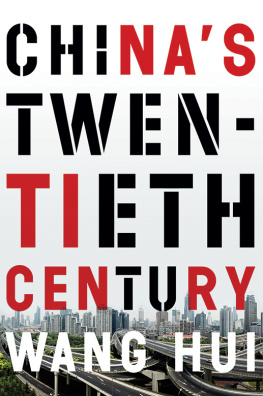CHINAS GRAIN ECONOMY
Chinas Grain Economy
The challenge of feeding more than a billion
LIMING WANG and JOHN DAVIS
Department of Agricultural and Food Economics
The Queens University of Belfast
United Kingdom
First published 2000 by Ashgate Publishing
Reissued 2018 by Routledge
2 Park Square, Milton Park, Abingdon, Oxon, OX14 4RN
52 Vanderbilt Avenue, New York, NY 10017
Routledge is an imprint of the Taylor & Francis Group, an informa business
Copyright Liming Wang and John Davis 2000
All rights reserved. No part of this book may be reprinted or reproduced or utilised in any form or by any electronic, mechanical, or other means, now known or hereafter invented, including photocopying and recording, or in any information storage or retrieval system, without permission in writing from the publishers.
Notice:
Product or corporate names may be trademarks or registered trademarks, and are used only for identification and explanation without intent to infringe.
Publishers Note
The publisher has gone to great lengths to ensure the quality of this reprint but points out that some imperfections in the original copies may be apparent.
Disclaimer
The publisher has made every effort to trace copyright holders and welcomes correspondence from those they have been unable to contact.
A Library of Congress record exists under LC control number:
ISBN 13: 978-0-367-13515-7 (hbk)
ISBN 13: 978-0-429-02693-5 (ebk)
Contents
AAPCs | Advanced Agricultural Producers Co-operatives |
CAAS | Chinese Academy of Agricultural Science |
CADB | China Agricultural Development Bank |
CPC | Communist Party of China |
EAPCs | Elementary Agricultural Producers Co-operatives |
FAO | Food and Agricultural Organisation |
GDP | Gross Domestic Product |
GNP | Gross National Product |
HRS | Household Responsibility System |
IFTE | Institute of Finance and Trade Economics |
IPA | Institute of Public Administration |
LDCs | Less Developed Countries |
MATs | Mutual Aid Teams |
MCI | Multiple Cropping Index |
MIT | Ministry of Internal Trade |
MoA | Ministry of Agriculture |
NAZC | National Agricultural Zoning Committee |
OECF | Overseas Economic Cooperation Fund |
RMB | Renminbi |
RTSPC | Research Team of the State Planning Commission and Statistics Bureau |
SSB | State Statistical Bureau |
TVEs | Township-village enterprises |
USDA | United States Department of Agriculture |
WTO | World Trade Organisation |
Any discussions about the future of the global grain economy fairly quickly turn to consideration of the situation in China; such is the perceived central importance of the country in determining the future path of world grain markets. Can the country, with one of the lowest areas of cultivated land per person in the world, continue herself to feed a population in excess of 1.2 billion? Indeed, will she wish to do so in the future or will rural industrialisation force her to become more integrated into the global grain market, thus reversing the political imperatives of a generation? Will the rural reform process run out of steam and what, if anything, can be done to reinvigorate the reforms? Most fundamentally, what are the underlying driving forces of the Chinese grain economy and how will these be affected by future uncertainty and change. It is with these and related questions that it has been our privilege to wrestle with and debate over the last ten years. It has been a most stimulating and rewarding experience in the course of which we have been able greatly to extend our networks within China. Our mission in writing this book has been an ambitious one namely to employ the tools of economic analysis to develop a detailed understanding of the functioning of the Chinese grain economy; and to use those insights to project the future path of its development. We are content that we have significantly advanced our understanding of this complex system, to a level which we have not seen in other volumes. This gives us considerable confidence in the realism of our estimates of the future shape of the Chinese grain economy in the new millennium. Of course we are aware of some of the flaws and pitfalls in our approach. In particular our analysis is partial in that our models do not explicitly take account of the likely extent of Chinas integration with global markets; though we would argue that this is implicit in our modelling assumptions. Also, we have encountered considerable data problems, due partly to our long data periods and the difficulty in finding consistent, reliable and up to date data series. However, as we set out in the book, we have taken considerable time and made every effort over our data sets and are as happy as we can be in the circumstances with the quality of our data. We hope that the reader will gain fresh insights and knowledge of the rural reform process in China and the functioning of its complex grain sector; and that our projections in particular will add authoritatively to an understanding of the likely future impact of that sector both within China and in world markets. We conclude that Chinas achievements in grain are the legacy of Deng Xiaoping and the triumph of farmers and the market.
Liming Wang is Director of China Unit at The Queens University of Belfast and a former employee of the Ministry of Commerce in Beijing. John Davis is Head of Agricultural and Food Economics in Queens University and former Director of the Gibson Institute. He is co-author of a recent book on the economics of grain marketable surplus supply in Chinese farm households.
Dr Liming Wang, Dr John Davis
Department of Agricultural and Food Economics
The Queens University of Belfast
Newforge Lane
Belfast, BT9 5PX
United Kingdom
Email: l.wang@qub.ac.uk; john.davis@qub.ac.uk
This book could not have been written without the help, support and encouragement of a considerable number of individuals. We are particularly grateful to colleagues in the Department of Agricultural and Food Economics, The Queens University of Belfast for their assistance with various aspects of our work. We are indebted to Mrs Hilary McErlean and staff in the Secretarial Centre for their expert advice and assistance in the preparation of the camera-ready copy; and to Mrs Margaret McParland for her detailed proof reading. Thanks are due also to the library staff in the School of Agriculture and Food Science for their courtesy and efficiency in obtaining a wide range of, sometimes obscure, articles and books. We would like to thank our numerous contacts in China who helped us solve our many data problems. Finally, a special thanks to the Chinese Economic Association (UK) for the opportunities afforded us to present and debate our ideas.





